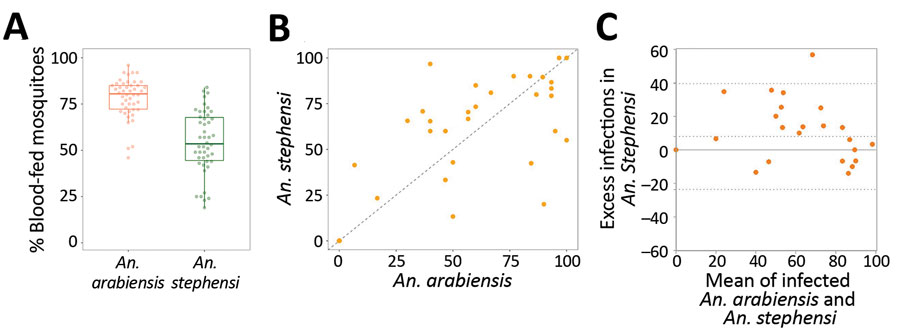Anopheles stephensi Mosquitoes as Vectors of Plasmodium vivax and falciparum, Horn of Africa, 2019
Fitsum G. Tadesse
1
, Temesgen Ashine
1, Hiwot Teka, Endashaw Esayas, Louisa A. Messenger, Wakweya Chali, Lisette Meerstein-Kessel, Thomas Walker, Sinknesh Wolde Behaksra, Kjerstin Lanke, Roel Heutink, Claire L. Jeffries, Daniel Abebe Mekonnen, Elifaged Hailemeskel, Surafel K. Tebeje, Temesgen Tafesse, Abrham Gashaw, Tizita Tsegaye, Tadele Emiru, Kigozi Simon, Eyuel Asemahegn Bogale, Gedeon Yohannes, Soriya Kedir, Girma Shumie, Senya Asfer Sabir, Peter Mumba, Dereje Dengela, Jan H. Kolaczinski, Anne Wilson, Thomas S. Churcher, Sheleme Chibsa, Matthew Murphy, Meshesha Balkew, Seth Irish, Chris Drakeley, Endalamaw Gadisa, and Teun Bousema
Author affiliations: Armauer Hansen Research Institute, Addis Ababa, Ethiopia (F.G. Tadesse, T. Ashine, H. Teka, E. Esayas, W. Chali, S.W. Behaksra, D.A. Mekonnen, E. Hailemeskel, S.K. Tebeje, T. Tafesse, A. Gashaw, T. Tsegaye, T. Emiru, E.A. Bogale, G. Shumie, S.A. Sabir, E. Gadisa); Radboud University Medical Center, Nijmegen, the Netherlands (F.G. Tadesse, L. Meerstein-Kessel, K. Lanke, R. Heutink, E. Hailemeskel, S.K. Tebeje, T. Bousema); Addis Ababa University, Addis Ababa (F.G. Tadesse, D.A. Mekonnen, E. Hailemeskel); United States Agency for International Development, Addis Ababa (H. Teka, S. Chibsa, M. Murphy); London School of Hygiene and Tropical Medicine, London, UK (L.A. Messenger, T. Walker, C.L. Jeffries, K. Simon, C. Drakeley, T. Bousema); President’s Malaria Initiative VectorLink Ethiopia Project, Addis Ababa (G. Yohannes, P. Mumba, M. Balkew); Oromia Regional Health Bureau, Adama, Ethiopia (S. Kedir); President’s Malaria Initiative VectorLink Project, Rockville, Maryland, USA (D. Dengela); World Health Organization, Geneva, Switzerland (J.H. Kolaczinski); Liverpool School of Tropical Medicine, Liverpool, UK; (A. Wilson); Imperial College London, London (T.S. Churcher); United States President’s Malaria Initiative, Atlanta, Georgia, USA (S. Chibsa, M. Murphy, S. Irish); Centers for Disease Control and Prevention, Atlanta (S. Irish)
Main Article
Figure 1

Figure 1. Comparison of feeding efficiency and infection rates for Anopheles stephensi and An. arabiensis mosquitoes in paired feeding experiments in study of An. stephensi mosquitoes as vectors of Plasmodium vivax and falciparum, Horn of Africa, 2019. A) Percentage of fully fed An. arabiensis mosquitoes (red) and An. stephensi mosquitoes (green). Box plots indicate median (midline), 25th (lower line), and 75th (upper line) percentiles of proportion of blood-fed mosquitoes. Whiskers indicate lower and upper 25% scores. Vertical lines indicate minimum and maximum values. B) Percentage of infected mosquitoes. C) Bland-Altman plot (difference plots) for mosquito infection rates in different mosquito species. Symbols indicate differences in infection rates in An. stephensi versus An. arabiensis (y-axis) mosquitoes in relation to mean infection rates in these 2 species (x-axis). Positive values (57.1%; 16/28) indicate a higher infection rate in An. stephensi mosquitoes; dotted lines indicate the 95% limits of agreement. There was no evidence that the correlation coefficient between the paired differences and means differed significantly from 0 (Pitman test of difference in variance, r = 0.026, p = 0.864).
Main Article
Page created: January 08, 2021
Page updated: January 24, 2021
Page reviewed: January 24, 2021
The conclusions, findings, and opinions expressed by authors contributing to this journal do not necessarily reflect the official position of the U.S. Department of Health and Human Services, the Public Health Service, the Centers for Disease Control and Prevention, or the authors' affiliated institutions. Use of trade names is for identification only and does not imply endorsement by any of the groups named above.
